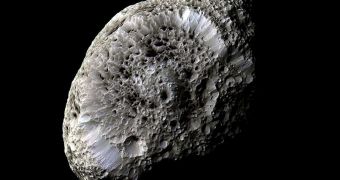Astronomers are currently refocusing their attention on the Saturnine moon Hyperion, one of the most interesting space rocks orbiting the gas giant. The body looks like a sponge, and is tremendously battered by impacts, yet there are still many things that experts still don't known about it.
This particular view of the moon was taken by the NASA Cassini orbiter on September 26, 2005. Six individual images were pieced together to give this detailed photograph of the rock.
One of the most puzzling things about this particular structure is the fact that it has a sponge-like appearance and a very low density. It also has weak surface gravity and high porosity, which gives it its distinctive look.
When Hyperion was first imaged, experts believed that a phenomenon called thermal erosion was responsible for the sponge-like appearance.
This natural process affects rocky space bodies. It takes place when dark materials at the bottom of craters are heated up by sunlight, melt, and then go deeper into the space rock carrying them.
As this happens, the surrounding ices are vaporized, and the weird appearance is generated. But further studies have shown that this was not the case on the Saturnine moon.
For such a large moon, with a mean radius of 135 kilometers, it has a very low density. The weak gravitational pull it exerts most likely led to this peculiar structure.
Additionally, Hyperion had a very active history. Since its formation, it has been impacted by countless asteroids and meteorites, as evidenced by the multitude of craters on its surface, Space Fellowship reports.
In this image, the extent of the damage, as well as the irregular shape of the moon become apparent. The photos were taken from 33,000 kilometers (20,500 miles), about a year after Cassini achieved orbital insertion around Saturn.
The moon was found in 1848 by astronomers William Cranch Bond, George Phillips Bond and William Lassell. One of the things that were observed from get-go included its irregular shape and its chaotic rotation pattern, that defied classification at the time.
Since it arrived at Saturn, on July 1, 2004, Cassini has carried our a large number of flybys around numerous moon, including Titan, Enceladus, Rhea and Dione.
The mission is managed by experts at the NASA Jet Propulsion Laboratory (JPL), a division of the California Institute of Technology (Caltech), in Pasadena.

 14 DAY TRIAL //
14 DAY TRIAL //